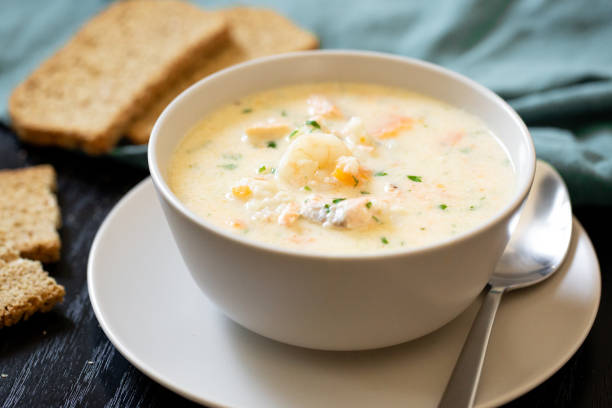Chowder, a rich and hearty soup, is a beloved dish in many cultures, especially in coastal regions where seafood is abundant. It typically consists of ingredients like seafood (such as clams, fish, or shrimp), potatoes, onions, and celery, all simmered in a creamy or broth-based soup. While chowder is often viewed as a comfort food, it also offers a variety of nutritional benefits. This essay explores the nutritional value of chowder and how it can be part of a balanced diet.

One of the primary nutritional benefits of chowder, particularly seafood chowder, is its high protein content. Seafood, such as clams, fish, or shrimp, provides a lean source of high-quality protein, which is essential for muscle repair and growth, immune function, and overall body maintenance. Protein from seafood is also rich in essential amino acids, which the body cannot produce on its own. For instance, clam chowder is particularly high in protein, offering about 15-20 grams per serving, depending on the recipe. Fish like cod or haddock, often used in fish chowder, are also excellent sources of protein.

Seafood is well-known for being rich in omega-3 fatty acids, particularly EPA and DHA, which are crucial for heart health. Omega-3s help reduce inflammation, lower blood pressure, and decrease the risk of heart disease and stroke. They are also important for brain health, supporting cognitive function and reducing the risk of neurodegenerative diseases. Including seafood in chowder can help meet your body’s needs for these essential fats, contributing to overall cardiovascular and brain health.

Chowder contains a variety of vitamins and minerals that are essential for good health. Seafood is rich in vitamins B12 and D, as well as minerals like selenium, iodine, and zinc. Vitamin B12 is important for red blood cell formation and nerve function, while vitamin D is crucial for bone health and immune function. Selenium acts as an antioxidant, helping to protect cells from damage, and iodine is necessary for thyroid function. Potatoes, a common ingredient in chowder, provide vitamin C, potassium, and fiber. Vitamin C is an antioxidant that supports immune health, while potassium is essential for maintaining healthy blood pressure and heart function.

Potatoes, which are often a key ingredient in chowder, are a good source of carbohydrates, providing energy to the body. They also contribute dietary fiber, which aids in digestion, helps regulate blood sugar levels, and promotes satiety. Fiber can also lower cholesterol levels, which is beneficial for heart health. The type of carbohydrates found in potatoes are mostly complex carbs, which provide a slow and steady release of energy, helping to keep blood sugar levels stable.

Chowder, particularly creamy versions, can be made with a base of milk, cream, or butter, which contributes to its fat content. While these ingredients can add saturated fat, they also provide essential fat-soluble vitamins like vitamins A, D, E, and K. For a healthier option, some recipes use lower-fat milk or substitute part of the cream with broth to reduce the saturated fat content while still maintaining a creamy texture. Additionally, if the chowder includes olive oil or another healthy fat in its preparation, it can provide monounsaturated fats, which are beneficial for heart health.

Onions, garlic, and celery, which are commonly used in chowder, are rich in antioxidants and possess anti-inflammatory properties. Onions and garlic, in particular, contain compounds like quercetin and allicin, which help reduce inflammation and oxidative stress in the body. These ingredients not only add flavor to the chowder but also contribute to overall health by supporting the immune system and reducing the risk of chronic diseases.
While chowder offers numerous nutritional benefits, it is important to consider its preparation method and portion size. Traditional creamy chowders can be high in calories and saturated fat, which may not align with certain dietary goals. To make chowder healthier, consider using less cream or replacing it with low-fat milk or broth. Including plenty of vegetables and using leaner seafood can also enhance the dish’s nutritional profile.

Chowder, with its combination of seafood, vegetables, and creamy or broth-based soup, is a nutrient-rich dish that provides high-quality protein, essential vitamins and minerals, healthy fats, and fiber. While it is often seen as a comfort food, chowder can also be a part of a balanced diet, offering a range of health benefits, from supporting muscle and heart health to providing antioxidants that protect against chronic disease. By making thoughtful ingredient choices and considering portion sizes, chowder can be enjoyed as a delicious and nutritious meal that contributes to overall well-being.




Finding curated AI tools can save so much time-tyy.AI really nails that. Their AI Facebook Assistant is a great example of streamlining social media tasks.
https://shorturl.fm/msXWO
https://shorturl.fm/2ENFM
https://shorturl.fm/Upwth
https://shorturl.fm/Y2HZX
https://shorturl.fm/36MRR
https://shorturl.fm/56TIQ
https://shorturl.fm/1Zxzw
https://shorturl.fm/sdD8i
https://shorturl.fm/pePjA
https://shorturl.fm/pwqV5
https://shorturl.fm/UQUpT
https://shorturl.fm/d3T96
https://shorturl.fm/JtN4E
https://shorturl.fm/Q82df
https://shorturl.fm/4p92b
https://shorturl.fm/mGrhx
https://shorturl.fm/xTEUZ
https://shorturl.fm/a8y9y
https://shorturl.fm/iZ5Pd
https://shorturl.fm/UXadr
https://shorturl.fm/r57CS
https://shorturl.fm/QWbNQ
https://shorturl.fm/mMKRT
https://shorturl.fm/jwypm
https://shorturl.fm/seO4y
https://shorturl.fm/e0301